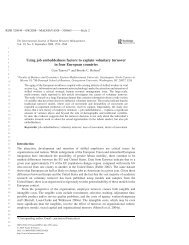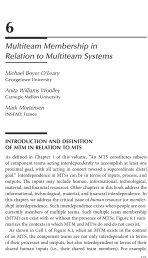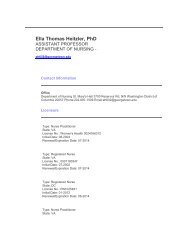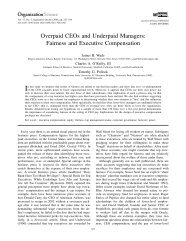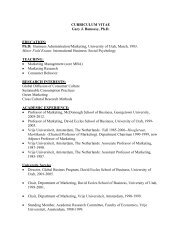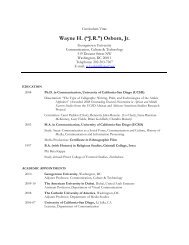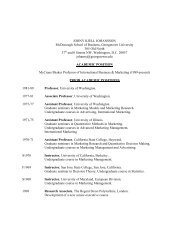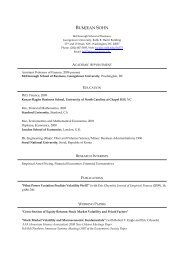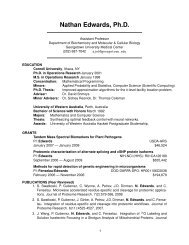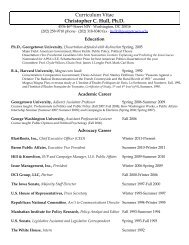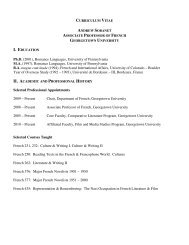et al - Georgetown University
et al - Georgetown University
et al - Georgetown University
You also want an ePaper? Increase the reach of your titles
YUMPU automatically turns print PDFs into web optimized ePapers that Google loves.
Epidemiologic Studies of MMR<br />
Vaccine and Autism<br />
Michael A. Stoto, PhD<br />
Sean D. Cleary, PhD<br />
Virginia B. Foster, PhD<br />
Department of Epidemiology and Biostatistics<br />
George Washington <strong>University</strong>
Outline of presentation<br />
Epidemiology of<br />
– autism<br />
– inflammatory bowel disease<br />
Wakefield study<br />
– MMR vaccine, autism, and bowel disease<br />
Studies regarding MMR and autism<br />
Studies regarding MMR and bowel disease<br />
Summary and conclusions
Disclaimer<br />
GW authors are not experts in the substantive<br />
areas covered, but assessed the tot<strong>al</strong>ity of the<br />
available epidemiologic evidence<br />
– comments and suggestions gratefully accepted!<br />
Although commissioned by the IOM, the<br />
conclusions in this paper are not binding on the<br />
IOM<br />
– other factors might enter into caus<strong>al</strong>ity assessment<br />
– other factors might enter into conclusions and<br />
recommendations
Epidemiology of autism<br />
Pervasive development<strong>al</strong> disorders (PPD)<br />
– R<strong>et</strong>t’s disorder<br />
– childhood disintegrative disorder<br />
– autistic spectrum disorder (ASD)<br />
» Asperger’s disorder (ASP)<br />
» autism (usu<strong>al</strong>ly no period of “unequivoc<strong>al</strong>ly norm<strong>al</strong><br />
development”)<br />
» PPD not otherwise specified (PPD-NOS)<br />
childhood disintegrative disorder (CDD)<br />
atypic<strong>al</strong> autism (later age of ons<strong>et</strong>, atypic<strong>al</strong> or<br />
subthreshold symptom)
Epidemiology of autism<br />
Prev<strong>al</strong>ence of autism (per 10,000) (Fombonne)<br />
– Median: 5.2; Range: 0.7 to 31.0<br />
– Before 1988: 4.3; 1988-1999: 7.2<br />
Trends<br />
– Gillberg and Wing: 3.8% increase per c<strong>al</strong>endar year<br />
– Kaye <strong>et</strong> <strong>al</strong>.: 8 to 29 in 2-5 year old boys b<strong>et</strong>ween 1988<br />
and 1993 in UK<br />
– CA Dept. of Development<strong>al</strong> Services: 15.0 may<br />
reflect increased awareness of availability of services<br />
Etiology: not much known
Epidemiology of bowel disease<br />
Inflammatory bowel disease (IBD)<br />
– Crohn’s disease (CD)<br />
– ulcerative colitis (UC)<br />
Incidence of IBD (per 100,000 person years)<br />
– CD: 0.08 to 7.0<br />
– UC: 0.5 to 12.8<br />
– higher in northern areas including UK<br />
– increasing in other countries to UK levels<br />
– compare with caution due to varying diagnostic<br />
criteria and access to medic<strong>al</strong> care
Epidemiology of bowel disease<br />
Etiology gener<strong>al</strong>ly unknown, but<br />
– family history is important<br />
– higher in urban than rur<strong>al</strong> populations<br />
– smoking increases risk<br />
» especi<strong>al</strong>ly for women<br />
» children exposed to passive smoking<br />
– other suggested factors<br />
» or<strong>al</strong> contraceptives, paramyxovirus, stress<br />
» inefficient immune system response<br />
» di<strong>et</strong>ary habits, breast feeding (decreased risk)
The Wakefield study<br />
Case series of 12 children<br />
– referred to pediatric gastroenterology department with<br />
intestin<strong>al</strong> symptoms<br />
– with history of PDD with loss of acquired skills<br />
11/12 found to have non-specific colitis<br />
– not CD or UC<br />
PPD diagnoses<br />
– 8 with “definitive diagnosis of autism”<br />
– 1 “questionable and possible disintegrative disorder”<br />
– 1 “autistic spectrum disorder”<br />
– 2 “post-vaccini<strong>al</strong> enceph<strong>al</strong>itis?”<br />
» neither term nor ? discussed in paper
The Wakefield study<br />
Urinary m<strong>et</strong>hylm<strong>al</strong>onic acid excr<strong>et</strong>ion<br />
significantly elevated compared to controls<br />
– age-matched and from same site, but selection not<br />
described<br />
MMR was the “exposure identified by parents or<br />
a doctor” in 6/8 cases with definitive autism<br />
– other 2 did receive MMR, but not identified as the<br />
“primary exposure”<br />
– MMR <strong>al</strong>so identified for 1 with questionable autism<br />
– MMR identified in 1/2 with “post-vaccini<strong>al</strong><br />
enceph<strong>al</strong>itis?”
The Wakefield study<br />
No reported d<strong>et</strong>ection of measles virus RNA in intestin<strong>al</strong><br />
tissue or otherwise<br />
Measles virus RNA was d<strong>et</strong>ected in peripher<strong>al</strong> blood<br />
mononuclear cells using RT-PCR/nested PCR from a<br />
subs<strong>et</strong> (?) of the 12 autistic enterocolitis patients (3/9)<br />
– Kawashima (2000)<br />
Unknown significance of measles virus d<strong>et</strong>ection without<br />
comparable non-affected pediatric control group<br />
– control group not clearly described in paper
The Wakefield study<br />
Authors conclude that they have “identified a<br />
chronic enterocolitis in children that may be<br />
related to neuropsychiatric dysfunction”<br />
– typic<strong>al</strong>ly follows a period of apparent norm<strong>al</strong><br />
development after which children lose skills<br />
– “in most cases, ons<strong>et</strong> of symptoms was after” MMR<br />
vaccination<br />
The study “did not prove an association” b<strong>et</strong>ween<br />
MMR and the syndrome described
The Wakefield study<br />
Association in epidemiologic studies<br />
– compare individu<strong>al</strong>s with and without a certain<br />
exposure (MMR) to see if the outcome (autism) is<br />
higher in the exposed group<br />
– compare cases (individu<strong>al</strong>s with the outcome) to<br />
controls without the outcome to see if cases are more<br />
likely to have been exposed<br />
“Association” in this study reflects opinions of<br />
patents and physicians, not statistic<strong>al</strong> association<br />
– difficult to assess unless proximate in time<br />
– might be b<strong>et</strong>ter to c<strong>al</strong>l this “attribution”
The epidemiologic ch<strong>al</strong>lenge<br />
Gathering epidemiologic evidence to support or<br />
refute Wakefield’s hypothesis presents a serious<br />
ch<strong>al</strong>lenge<br />
– the outcomes in question<br />
»rare<br />
» prev<strong>al</strong>ence and diagnostic criteria vary<br />
» may not have sharp ons<strong>et</strong> or be diagnosed promptly<br />
» <strong>et</strong>iologic factors are not well known<br />
– the exposure (MMR) is common
Studies of MMR and autism<br />
Case-control studies<br />
– UK: Miller <strong>et</strong> <strong>al</strong>. (1997)<br />
Case series<br />
– Finland: Peltola <strong>et</strong> <strong>al</strong>. (1998); Patja <strong>et</strong> <strong>al</strong>. (2000)<br />
– North East Thames (UK): Taylor <strong>et</strong> <strong>al</strong>. (1999)<br />
Ecologic<strong>al</strong> studies<br />
– UK: Kaye <strong>et</strong> <strong>al</strong>. (2001)<br />
– Sweden: Gilberg and Heijbel (1998)
UK: Miller <strong>et</strong> <strong>al</strong>.<br />
Based on Nation<strong>al</strong> Childhood Enceph<strong>al</strong>opathy Study<br />
(NCES), 1976-1979<br />
770 cases of acute enceph<strong>al</strong>opathy in “previously<br />
apparently neurologic<strong>al</strong>ly norm<strong>al</strong>” children<br />
– 16 had received measles vaccine 7 to 14 days prior<br />
– similar proportion in controls (RR 1.85; 95% CI 0.9 - 3.7)<br />
10-year follow-up of 594 (77%) cases<br />
– including 11/16 with measles vaccine<br />
– 3/11 died or had neurologic<strong>al</strong>, education<strong>al</strong>, or behavior<strong>al</strong><br />
dysfunction<br />
– similar proportion in controls (RR 0.84; 95% CI 0.2, 3.5)
Finland: Peltola <strong>et</strong> <strong>al</strong>.; Patja <strong>et</strong> <strong>al</strong>.<br />
Population-based passive surveillance data<br />
following nationwide MMR program<br />
– judgment of wh<strong>et</strong>her outcomes were caus<strong>al</strong>ly related<br />
to MMR based on available clinic<strong>al</strong> information and<br />
serum samples<br />
– 437 adverse events reported in 14 years (0 autism)<br />
– 31 cases of gastrointestin<strong>al</strong> symptoms<br />
» 5 febrile seizures, 2 headaches, 1 ataxia<br />
– 173 serious adverse events (in 169 people)<br />
» factors other than MMR account for up to 45%
NE Thames (UK): Taylor <strong>et</strong> <strong>al</strong>.<br />
Children with autistic disorders<br />
– born b<strong>et</strong>ween 1979 and 1992; identified in 1998 from<br />
computerized speci<strong>al</strong>ized needs/disability registries<br />
Information extracted on<br />
– age at diagnosis<br />
– age at first parent<strong>al</strong> concern<br />
– age at which regression first became obvious<br />
Diagnoses confirmed by checking available records<br />
– 82% of autism cases<br />
– 31% of atypic<strong>al</strong> autism cases<br />
– 38% of Asperger’s syndrome cases
NE Thames (UK): Taylor <strong>et</strong> <strong>al</strong>.<br />
Time series an<strong>al</strong>ysis to fit exponenti<strong>al</strong> trend to<br />
number of cases with core or atypic<strong>al</strong> autism<br />
– no evidence of a “step up” after 1987, when MMR<br />
vaccine was introduced in the UK<br />
Mean age at diagnosis not statistic<strong>al</strong>ly different<br />
among children who<br />
– received MMR before 18 months<br />
– never received MMR<br />
– received MMR after 18 months
NE Thames (UK): Taylor <strong>et</strong> <strong>al</strong>.<br />
Timing of diagnosis, first parent<strong>al</strong> concern, and<br />
regression in children who received MMR<br />
– Clustering of parent<strong>al</strong> concern within 6 months of<br />
diagnosis (RI 1.48; 95% CI 1.04 - 2.12) attributed to<br />
» peak in recorded concern at 18 months (rounding?)<br />
» peak in MMR vaccination at 13 months<br />
– No other statistic<strong>al</strong>ly significant clustering<br />
New (unpublished) study with longer induction<br />
interv<strong>al</strong> still finds no effect
UK: Kaye <strong>et</strong> <strong>al</strong>.<br />
Time trend an<strong>al</strong>ysis based on UK gener<strong>al</strong> practice<br />
research database (GPRD)<br />
305 cases of autism < 12 years of age diagnosed b<strong>et</strong>ween<br />
1988 and 1999<br />
– an<strong>al</strong>ysis restricted to boys born before 1994 with first diagnosis<br />
b<strong>et</strong>ween 2 and 5 years of age<br />
– 96% had received MMR<br />
Annu<strong>al</strong> incidence of autism increased from 0.3 to 2.1 per<br />
10,000 b<strong>et</strong>ween 1988 and 1993<br />
4-year risk of autism increased four-fold b<strong>et</strong>ween 1988<br />
and 1993, while prev<strong>al</strong>ence of MMR remained constant
Sweden: Gilberg and Heijbel<br />
Children diagnosed b<strong>et</strong>ween 1975 and 1984<br />
– 55 with autism by DSM-III-R criteria<br />
– 19 with autistic-like condition (atypic<strong>al</strong> autism)<br />
Birth cohorts defined relative to introduction of MMR<br />
– 47 cases (34 autism, 13 atypic<strong>al</strong> autism) born before July 1,<br />
1980<br />
– 27 cases (21 autism, 6 atypic<strong>al</strong> autism) born after July 1, 1980<br />
Since numbers in second period are much less than<br />
expected, the date does not support association b<strong>et</strong>ween<br />
MMR and autism
Summary: MMR and autism<br />
Focus of Miller study was on measles vaccine<br />
Most studies not focused on atypic<strong>al</strong> autism or<br />
regression<br />
An<strong>al</strong>ysis limited by<br />
– trends in diagnosis of development<strong>al</strong> disorders and<br />
possible background changes in prev<strong>al</strong>ence<br />
– difficulty of finding a time connection b<strong>et</strong>ween<br />
vaccination and ons<strong>et</strong> of autism<br />
Limited evidence about the Wakefield hypothesis
Studies of MMR and bowel disease<br />
Cohort studies<br />
– UK: Montgomery <strong>et</strong> <strong>al</strong>. (1999)<br />
– Olmstead County, MN: Pardi <strong>et</strong> <strong>al</strong>. (2000)<br />
– UK: Morris <strong>et</strong> <strong>al</strong>. (2000)<br />
– UK: Thompson <strong>et</strong> <strong>al</strong>. (1996)<br />
Case-control studies<br />
– East Dors<strong>et</strong>, UK: Feeny <strong>et</strong> <strong>al</strong>. (1997)<br />
– CA, OR, WA: Davis <strong>et</strong> <strong>al</strong>. (2001)
UK: Montgomery <strong>et</strong> <strong>al</strong>.<br />
Based on the 1970 British Cohort Study<br />
– 7019 individu<strong>al</strong>s born in April 1970 and followed<br />
through age 26<br />
37 individu<strong>al</strong>s with IBD (17 UC, 20 CD)<br />
– <strong>al</strong>l but one diagnosed at age 16 or older<br />
Measles infection < 2 years associated with UC<br />
but not significant (OR 3.7; 95% CI 0.97 - 13.8)<br />
Measles and mumps infection in same year<br />
associated with<br />
–UC(OR 7.5; 95% CI 2.4 - 23.0)<br />
–CD(OR 4.3; 95% CI 1.2 - 14.5)
Olmstead County, MN: Pardi <strong>et</strong> <strong>al</strong>.<br />
Eligible cohort: children seen for measles < age 5 at the<br />
Mayo or Olmstead County medic<strong>al</strong> centers from 1950<br />
through 1966<br />
– follow-up questionnaire or telephone survey (57%<br />
compl<strong>et</strong>e)<br />
– Standardized incidence rates based on Olmstead<br />
County<br />
Association b<strong>et</strong>ween early measles infection and IBD<br />
– IBD and measles < 2 years (SIR 4.4; 95% CI 1.1 - 8.7)<br />
– IBD and measles > 2 years (SIR 1.9; 95% CI 0.5 - 4.9)
UK: Morris <strong>et</strong> <strong>al</strong>.<br />
Based on the 1970 British Cohort Study<br />
– 7616 individu<strong>al</strong>s born in April 1970 followed through<br />
age 26<br />
– measles vaccination history at age 5 based on home<br />
parent<strong>al</strong> survey<br />
No association found b<strong>et</strong>ween measles<br />
vaccination by age 5 and later diagnosis with<br />
–UC(OR 0.57; 95% CI 0.2, 1.6)<br />
–CD(OR 0.67; 95% CI 0.3, 1.6)
UK: Thompson <strong>et</strong> <strong>al</strong>.<br />
Study of children in 1964 measles vaccine tri<strong>al</strong><br />
– annu<strong>al</strong> mailed follow-up surveys through 1994<br />
(n=3967)<br />
– compared to 1958 birth cohort (NCDS)<br />
Increase in vaccinated individu<strong>al</strong>s<br />
–UC(RR 2.05; p = 0.21)<br />
–CD(RR 2.95; p = 0.01)<br />
No significant difference in age at vaccination for<br />
UC or CD cases compared to <strong>al</strong>l individu<strong>al</strong>s<br />
vaccinated
East Dors<strong>et</strong>, UK: Feeny <strong>et</strong> <strong>al</strong>.<br />
140 cases in individu<strong>al</strong>s born in East Dors<strong>et</strong> b<strong>et</strong>ween<br />
1968 and 1991 with definite diagnosis of IBD<br />
– two controls randomly selected from same GP,<br />
matched on gender and year of birth<br />
– vaccination history through age 5 obtained from GP<br />
records<br />
No association b<strong>et</strong>ween measles vaccination and<br />
–IBD(OR 0.97; 95% CI 0.6 - 1.5)<br />
–UC(OR 0.84; 95% CI 0.4 - 1.6)<br />
–CD(OR 1.08; 95% CI 0.6 - 1.8)
CA, OR, WA: Davis <strong>et</strong> <strong>al</strong>.<br />
Vaccine Saf<strong>et</strong>y Dat<strong>al</strong>ink study in children<br />
enrolled in HMOs from 6 months of age or<br />
younger b<strong>et</strong>ween 1958 and 1989<br />
142 cases diagnosed as definite, probably,<br />
possible, or questionable IBD (75 CD and 67 UC)<br />
– up to 5 controls matched by HMO, gender, birth year<br />
–MMRexposure based on medic<strong>al</strong> review of lif<strong>et</strong>ime<br />
vaccination history<br />
No statistic<strong>al</strong>ly significant association b<strong>et</strong>ween<br />
MMR and IBD
Vir<strong>al</strong> d<strong>et</strong>ection<br />
Wakefield (1993), Lewin (1995), Miyamoto (1995) and<br />
Daszak (1997) report evidence of measles virus in<br />
intestin<strong>al</strong> tissue of individu<strong>al</strong>s with CD<br />
– using electron microscopy, in situ hybridization, or monoclon<strong>al</strong><br />
antibody to measles virus<br />
Haga (1996), Afz<strong>al</strong> (1998), and Chadwick (1998) find no<br />
d<strong>et</strong>ectable measles virus in intestin<strong>al</strong> tissue and<br />
peripher<strong>al</strong> blood mononuclear cells<br />
– using RT-PCR/nested PCR techniques<br />
– adults (ages 17-65) with UC, CD, and ind<strong>et</strong>erminate colitis<br />
No individu<strong>al</strong>s diagnosed with autism and enterocolitis<br />
are included in these studies
Summary: MMR and IBD<br />
Limited evidence of an association b<strong>et</strong>ween<br />
measles vaccine or infection and IBD<br />
– Measles vaccine or measles infection, not MMR<br />
– IBD (UC and CD), not non-specific colitis<br />
An<strong>al</strong>ysis limited by<br />
– accuracy of r<strong>et</strong>rospective diagnoses<br />
– differing definitions of IBD<br />
Almost no evidence about the Wakefield<br />
hypothesis
Conclusions<br />
Wakefield hypothesis<br />
– focused on 3-way relationship among MMR, atypic<strong>al</strong> autism<br />
with regression, and non-specific colitis<br />
– based on “attribution” of cause by physicians and parents<br />
Other epidemiologic studies<br />
– focused on 2-way relationship b<strong>et</strong>ween MMR and PDD or IBD<br />
– different outcomes and som<strong>et</strong>imes different exposures<br />
– difficulties of studying rare outcomes<br />
Epidemiologic<strong>al</strong> evidence reviewed here is inadequate to<br />
accept or reject a caus<strong>al</strong> relationship b<strong>et</strong>ween MMR and<br />
autism
MMR and autism evidence model<br />
MMR<br />
Measles vaccine<br />
Measles infection<br />
PDD<br />
Autism<br />
Atypic<strong>al</strong> autism<br />
w/ regression (CDD?)<br />
Non-specific colitis<br />
IBD<br />
CD, UC
Categories of evidence for a caus<strong>al</strong><br />
relation (Source: IOM, 1991, 1994)<br />
Strength of<br />
evidence<br />
Evidence favors<br />
rejection<br />
Evidence favors<br />
acceptance<br />
Evidence<br />
establishes<br />
Evidence is inadequate<br />
1.0<br />
No evidence<br />
RR
Disclaimer<br />
GW authors are not experts in the substantive<br />
areas covered, but assessed the tot<strong>al</strong>ity of the<br />
available epidemiologic evidence<br />
– comments and suggestions gratefully accepted!<br />
Although commissioned by the IOM, the<br />
conclusions in this paper are not binding on the<br />
IOM<br />
– other factors might enter into caus<strong>al</strong>ity assessment<br />
– other factors might enter into conclusions and<br />
recommendations



